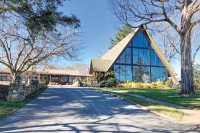Solar farm comes to Bethel
 The agricultural community of Bethel now has a new type of farm in its midst — solar.
The agricultural community of Bethel now has a new type of farm in its midst — solar.
Visible from U.S. 276, the 8.2-acre property sandwiched between the Bethel Community Cemetery and Exxon-Mobil gas station holds more than 6,000 solar panels, each 6 feet, 5 inches long and 3 feet, 3 inches wide. The whole array has a size of 1.5 megawatts, a rating that allows it to produce 2.9 million kilowatt-hours per year, enough to power 240 average U.S. homes.
“What solar does and smaller distributed generation plants such as this solar farm does is it allows power plants to be all over the place,” said Frank Marshall, director of policy and public affairs for FLS energy, the Asheville-based company behind the project. “You have distributed power throughout the state. It makes for a more robust grid, and also from a national security standpoint, that’s what we need to head towards.”
https://casite-498466.cloudaccess.net/archives/item/16850-solar-farm-comes-to-bethel#sigProId362eda77ca
Power generated from solar projects is most effective when it’s used locally, so homes in the new farm’s immediate vicinity are the ones whose dishwashers and light bulbs are now powered by solar. How it works is that FLS, which holds a 20-year lease on the land, sells the wattage it produces back to the power company — in this case, Duke Energy. Duke pays FLS for the power, and the energy goes into the pool of energy it uses to satisfy local customer demand.
“The most efficient way you can make power is make it on your roof, use it in your house,” Marshall explained. “The farther you push it, the more power you lose.”
Related Items
The folks at FLS should know. Founded in 2006, the firm is now the second largest solar company in the state and the fourth largest in the nation. The company employs 70 people at its Asheville headquarters and has brought $800 million of out-of-state investment to North Carolina since its inception.
More has changed in that time than just the company’s stats. The economic and legislative structure surrounding solar energy has seen some major shifts even since 2009, when FLS built its other Haywood County project, a solar farm on the Evergreen Packaging landfill in Canton.
“That was a pretty groundbreaking project,” Marshall said. “It was the first ballasted solar farm on a landfill in the eastern United States, or at least the Southeast.”
That solar farm had a size of 550 kilowatts, a massive undertaking for FLS at the time. The Bethel farm is more than triple that size, and it’s actually a small project compared to others on FLS’ plate right now.
A lot of the increased project size has to do with significant improvements to the economies of scale surrounding utility-size solar projects.
“Since we did our first project up in Canton, the prices for our installations have gone down by over 80 percent,” Marshall said. “When we started there was a North Carolina state tax credit. Well, we are going to continue to build even though that tax credit is sun-setting at the end of this year.”
For larger projects like the ones FLS now does, solar will still be a lucrative business without the 35 percent state tax break, even taking into account the fact that the sale price per kilowatt-hour of solar energy is significantly less now than it was in 2006, thanks to dropping prices for natural gas.
The reason?
“Sheer volume,” Marshall said. “A residential company might do in a year 250 kilowatts. We don’t even do that as a (single) project.”
Each residential or commercial project — those intended to power a single home or business — is much, much smaller than a project FLS might tackle. This year, FLS will install about 1,000 times the solar capacity of a residential company doing 250 kilowatts. The large scale makes it easier for FLS to find efficiencies and absorb costs than it might be for the smaller residential solar company and that’s why, Marshall said, even though utility-scale solar is at a place where it’s fine without the tax credit, residential and commercial projects aren’t there yet.
“We as a company would like to see some kind of a tax credit for it, even though we’re not in that business,” he said.
For utility-scale projects, the tax credit was instrumental in giving companies the cushion they needed to make North Carolina one of the top solar producers in the country, Marshall said. The tax break, coupled with a law requiring power companies to derive 12.5 percent of their energy from renewables by 2021, “really kickstarted the industry,” Marshall said.
Though utility-scale solar has certainly become more mainstream and the projects have grown larger, the mountains still present significant challenges for solar installers. Though it’s based just a stone’s throw away in Asheville, FLS doesn’t have any North Carolina projects further west than Haywood County.
“When you get into the mountains, it just opens up another variety of issues with building,” Marshall said.
For one thing, there’s the issue of slope — finding clear, flat land capable of housing solar panels can be difficult.
But there’s another reason the mountains are tricky for solar. The company secures its solar panels by driving metal pilings into the ground, not by pouring cement. In the mountains, rock generally isn’t all that far from the ground’s surface, so it can be pretty hard to find a place where it’s cost-effective to build.
Though, no matter what the project, solar is always an investment that takes some time to yield a return. For the Bethel project, FLS expects to wait five or six years before turning a profit.
“We’re in it for the long-term,” Marshall said.










